K - Abbreviation for degrees kelvin.
ka - In ancient Egypt, immortal human substance; the concept approximates the Western idea of the spirit or soul. One of Egypt's hieroglyphs is a ka, a figure with two bent arms.
(pr. kah)
An example of a ka in the second sense, symbolizing the first:
Egypt, Libation dish, c. 2960-2770 BCE, Dynasty 1, Archaic period, siltstone, width 5 3/4 inches (14.5 cm), length 6 7/8 inches (17.5 cm), Metropolitan Museum of Art, NY. See Egyptian art.
kachina - Any supernatural being important in the religion of the Hopi and Zuni Indians of Arizona, USA, represented in painted figurines (kachina dolls) and in costumes of ritual impersonators wearing masks and costumes. Also spelled katsina.
(pr. kə-CHEE-nə or Kə-TSEE-nə)
Examples:

Zuni, Buffalo Kachina, c. 1875, wood,
cloth, hide, fur, shell, feathers,
horse hair, tin cones,
Millicent Rogers Museum, Taos, NM.

Hopi, Spotted Kokosori, date unknown, carved
and painted cottonwood root, feathers
and string, Cranbrook Institute of Science.
Hopi, Tocha, or Hummingbird Kachina, date unknown, carved and painted cottonwood root, University of Michigan Museum of Anthropology, Ann Arbour, MI. A Kachina of the Kiva Dances of winter and Soyohim Dances in the spring.
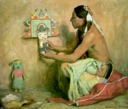
Eanger Irving Couse (American, 1866-1936),
Hopi
Kachina Maker, 1929, oil
on canvas.
kagle - A rough, highly abstracted African mask of the Dan people.
kakemono - In Japanese art tradition, a painting mounted for hanging vertically.
Example:

Hakuin Ekaku (Japanese, 1685-1768), Daruma, hanging scroll, ink on paper, chop
marks, 44 1/2 x 19 3/4 inches
(113 x 50.2 cm), Los Angeles County Museum of Art, CA. Daruma
(Sanskrit: Bodhidharma) was Zen's
first patriarch, a legendary meditation master who traveled from
India to China in the sixth century. His teachings were radically
different from the elaborate, ritualistic schools of Buddhism that were then prevalent. Haquin
Ekaku was also a reknowned Zen master.
Also see kakemono-e and makimono.
kakejiku - In Japanese art tradition, a hanging scroll used for mounting pieces of calligraphy.
kakemono-e - In Japanese art tradition, a print made as a substitute for a kakemono.
Kamakura - A period in Japanese art history from 1185-1333. It was preceded by the Heian period (794-1185) and followed by the Muromachi/Ashikaga period (1392-1573).
Examples of Kamakura art:

Rai Kunitoshi (Japanese, active c. 1290-1320),
Blade for a Dagger (Tanto), late 13th-early
14th century, Kamakura period, steel,
Metropolitan Museum of Art, NY.

Japan, Kamakura period, Storage Jar,
13th-14th century, Tokoname ware,
stoneware with
ash glaze, 15 1/2 x 18 3/4
inches (diameter) (39.4 x
47.6 cm), Los Angeles County Museum of Art.

Japan, Armor
(Yoroi), early 14th century, Late Kamakura period, lacquered iron and leather,
silk, stenciled leather,
copper-gilt,
height 37 1/2 inches (95.3
cm), weight 38 lb. 3 oz. (17.3
kg), Metropolitan Museum of Art, NY. See arms and armor.
kanshitsu - In Japanese art tradition, a technique of building up layers of lacquer reinforced with hemp over a clay core to form hollow sculpture.
kantharos - In ancient Greece, two-handled drinking cup. Also spelled cantharos. Another type of two-handled drinking cup is a kylix. Among the other types of Greek vases are the alabastron, amphora, hydria, krater, kyathos, lekythos, oinochoe, pelike, phiale, pinax, pithos, and pyxis.
Also see vessel.
karat - A unit of weight for gemstone, one karat is equal to one fifth of a gram or 200 milligrams. Also spelled carat.
Example:
![]()
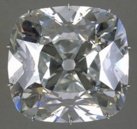
![]()
The Régent Diamond, 136 carats, 1 1/5 x 4/5 inches (3 x 2 cm), Louvre.
Also see jewelry.
karma - In Buddhist and Hindu belief, the ethical consequences of a person's life, which determine his or her fate.
Kassite art - See Mesopotamian art.
keeper - A student's artwork, which can be kept by the student because it has been made with enough of the qualities required by the teacher. If the keeper is ceramic, this assessment permits a piece to be fired as well as taken home by the student. Such a procedure can be useful in limiting waste, and in attaining various design standards.
keloid - See scarification.
kelvin - A unit of absolute temperature often used in photography to measure the color temperature of a source of light. Abbreviated K, kelvins can be converted to degrees Celsius by subtracting 273. Certain tungsten lamps are designed to burn at specific absolute temperatures (usually 3200 or 3400 K), guaranteeing that compatible photographic films will render the color they illuminate quite accurately.
Here are the color temperatures of common light sources:
| light source | color temperature | approximate decamired value |
| overcast sky | 6700-7000 K | 15 |
| electronic flash | 6200-6800 K | 16-15 |
| hazy sunlight | 5800 K | 17 |
| average daylight | 5500-6000 K | 18-17 |
| morning or afternoon sunlight | 5000-5500 K | 19 |
| 500-watt amateur photoflood lamps | 3400 K | 29 |
| 500-watt studio flood lamps | 3200 K | 31 |
| 100-watt general-service lightbulb | 2900K | 35 |
Also see color, incandescence, neon, phosphene, photon, stroboscopic, ultraviolet, value, and x-ray.
kerf - A slit, notch, or cut made by an ax, saw, blade, or cutting torch, or the width of such a space made by such tools. Sometimes, the first mark of this sort which establishes where the tool could go from there. Historically a kerf was made in wood, but today, a slit, notch, or cut made in metal, plastic, or another comparable material might also be called a kerf. A series of (usually parallel) kerfs are sometimes placed in a material in order to bend it, relieve stress, or prevent distortion. Kerfs have been used in bookbinding. This word, sometimes (although rarely) spelled "cerf," came to us from the same prehistoric word from which now have the word "carve."
Also see corrugate, crosscut saw, circular saw, declivity, hacksaw, miter, mortise, pleat, and ripsaw.
kern and kerning - In typography,
a kern is the projecting portion of a character
that overlaps the edge
of an adjacent letter. Kerning is the technique
of adjusting the spacing between
letters, usually to give them the appearance of more even (consistent)
spacing. A typographer might also speak of this as adjusting  the "letter
space." The original sense of kerning limited this adjustment
to closing the space enough to make letters' edges overlap. Letters
most often benefiting from kerning in this original sense include
i, l, and t. In the example
the "letter
space." The original sense of kerning limited this adjustment
to closing the space enough to make letters' edges overlap. Letters
most often benefiting from kerning in this original sense include
i, l, and t. In the example note the
space between the A and the V before and after kerning, and the
effect it has had on making the . When letter space between italic letters is adjusted, the
spaces preceding f, v, and w, are likely
to need kerning because the forward slope results in too much
space on the base line. Some ligatures,
including "æ", were formed by kerning. A ligature
is a single character made up of two or more letters joined together
as a standard element in a set of type
— e.g. æ (a+e) and Æ (A+E).
Also see graphic design, imbrication, leading, lettering, text, and typeface.

ketubah - In Jewish art tradition, a mariage contract, describing the obligations of the husband and wife. Especially among Sephardim (Jews of Spanish-Portuguese origin), the Ketubah has often been highly ornamented, decorated with intricate and colorful designs. Although many Jewish communities throughout the centuries have decorated their ketubot, Italian Jews during the 17th and 18th centuries stood out for cultivating the art of ketubah illumination. Italian ketubot commonly featured rich floral ornamentation and images from the Bible as well as from Greek and Roman mythology. They often depicted biblical personalities whose names were identical with those of the bride and groom, or they used images to identitfy their individual attributes (virtue, charity, etc.). The symbol of the spread out hands of the high priest denoted that the groom was of the priestly family (Kohen). Among the ketubah's provisions is the exact amount of money to be paid to the bride in the event of her bridegroom's death or of his divorcing her. An alternate spelling is ketubbah.
(pr. kə-TUH-bə)
The plural form of this Hebrew word is ketubot.
Examples:
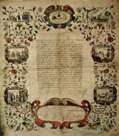
Dutch, Rotterdam, Ketubah, 1648, on parchment,
Israel Museum, Jerusalem. See Dutch art.
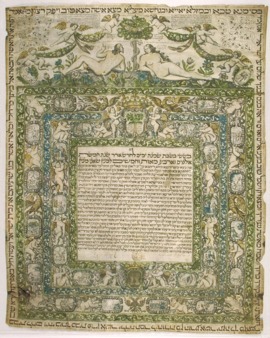
French, Nice, Ketubah of Bridegroom Jacob ben Samson Vallabrega
and Bride Rosa bat Joseph Kohen, 1690, on vellum,
Sholem Asch Collection. The scene above the text depicts Adam and Eve in the Garden
of Eden, echoing one of the seven blessings recited at the Jewish
wedding ceremony. The border surrounding the text includes miniature biblical
scenes, many of which relate to marriage.

Studio of Isidoro Baratta (Italian), Ketubah, 1751, pen,
ink, gouache, and gold
paint on parchment, 21 x 13
5/8 inches (53.3 x 34.5 cm), The Jewish Museum, NY.

Italian, Rome, Ketubah of Bridegroom Hananiah ben Reuben Mansi
and Bride Grazia bat Jacob Hayyim Azkariel, 1817, on
vellum, Sholem Asch Collection.

American, Ketubah of Sol Floersheim and Emma
Blumenthal, married by Rabbi Joseph Glueck, Montefiore Congregation,
Las Vegas, New Mexico, 7 Tebeth 5645 (December 25, 1884 CE).
Related links:
key
- A small interlocking device in the seam of a mold,
enabling the mold to be precisely reassembled. The term may also
refer to the slight roughening of a surface
which allows a  painted finish to adhere effectively.
painted finish to adhere effectively.
Also, it's a name given to wedges that stabilize canvas stretchers.These
can be seen here, driven into the interlocking corners of wooden stretcher bars to produce tension on canvas  support.
support.
To "key out" is to increase the outward stretch of the stretcher bars. A painting on canvas should always remain taut, but a painting that shows bulges can often be flattened by keying out the stretchers. A painting can be keyed out excessively. On a humid day a canvas might be so tightly stretched that when the humidity decreases it can rip apart. Old paintings on wooden frames with no keys or frames of other materials are often replaced with stretchers that can be keyed out.
In architecture, "key" refers to the keystone at the top of an arch.
Also see join.
![]()

![]()
keystone - The central and highest stone (voussoirs) in an arch. It cannot fall out of place because it is wedge-shaped, with the widest part of the wedge at the top. It is the last stone to be set in place during the construction of an arch. By pressing equally on either side it holds the arch together.
An example:
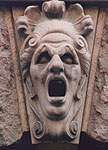
A carved
keystone on the City Hall in Stockholm, Sweden. See grotesque.
kg or kg. - Abbreviation for kilogram.
khutbah - In Islamic worship, a sermon and a declaration of allegiance to a community leader.
(pr. KOOT-bə)
kiblah - See qiblah.
kickwheel - A potter's wheel which is driven by kicking a revolving cement disk. The major alternative is a wheel driven by an electric motor.
Example:
![]()

![]()
A Leach wheel.
![]()
![]()

![]() kiln
- A special
kiln
- A special  oven
or furnace that can reach very high temperatures and is used to
bake, or fire clay.
Kilns may be electric, gas, or wood-fired. The one pictured here
is an electric model.
oven
or furnace that can reach very high temperatures and is used to
bake, or fire clay.
Kilns may be electric, gas, or wood-fired. The one pictured here
is an electric model.
(pr. kiln or kill)
Related link:
Also see monitor and pyrometric cones.
![]()
![]()

![]()
![]() Kiln-Sitter - A trademark
of W.P.
Dawson Inc. for a mechanical control designed to cut off electricity
to a kiln when a desired temperature
has been reached. At that temperature the pyrometric
cones placed in the Kiln-Sitter bends, or, in digital versions,
a touch-pad is used to program the firing of the kiln. As an additional
safety feature, every Kiln-Sitter also has a timer that shuts
off power to the kiln when the time
set by the operator has past.
Kiln-Sitter - A trademark
of W.P.
Dawson Inc. for a mechanical control designed to cut off electricity
to a kiln when a desired temperature
has been reached. At that temperature the pyrometric
cones placed in the Kiln-Sitter bends, or, in digital versions,
a touch-pad is used to program the firing of the kiln. As an additional
safety feature, every Kiln-Sitter also has a timer that shuts
off power to the kiln when the time
set by the operator has past.
kiln wash - A refractory mixture, usually kaolin or flint, which is mixed with water and painted on kiln shelves to prevent glaze from adhering. In Britain this is called bat wash, because a kiln shelf is called a bat.
Also see dry foot.
kilogram - A unit of weight measurement equal to 1000 grams. To convert kilograms into pounds (US), multiply them by 2.20462. Abbreviated kg.
kinesiologist - A scholar of motion who often uses photography to study the discrete phases of a particular movement. Also see cinema, horologist, kinetic, and science and art.
(pr. kə-NEE-zee-AH-lə-jist)
kinesthetic - The sensory experience of the body's movement. Physical awareness of the body's position in space.
(KI-nəs-THEH-tək)
Also see dance, interdisciplinary, and music.
kinetic - Expressing movement. In art, kinetic refers to sculpture that moves, such as a mobile.
(pr. kə-NE-tək)
Examples:
![]()
Naum Gabo (worked in Germany and USA, born
Russia, 1890-1977), Kinetic Construction (Standing Wave),
1919-20, replica 1985, metal, painted wood
and an electrical mechanism, 61.6 x 24.1 x 19.0 cm, Tate Gallery,
London. See Constructivism.

Naum Gabo, Model for 'Rotating Fountain', 1925,
reassembled 1986, metal and
plastic, 44.0 x 40.0 x 40.0
cm, Tate Gallery, London. This model
was enlarged into a full-scale
fountain, presumably with curved,
rotating arms. Originally sited
in a Dresden garden, it is now destroyed.
Harry Bertoia (American, born Italy, 1915-1978), Sounding Sculpture, 1965, beryllium copper, 15 3/4 x 10 x 5 inches, Kemper Museum of Contemporary Art, Kansas City, MO. See auditory.
Also see automata, dance, horology, music, rhythm, time, and whirligig.
kiss of death - When a paint brush is placed so that its brush-end is down, and it is abandoned long enough so that its bristles are permanently bent, it is often called the kiss of death!
![]()
![]()

![]()
![]()
kneaded eraser - An eraser that can be manipulated into any shape in order to remove pencil and many other marks cleanly. Also called a putty rubber.
Also see art gum eraser.
knowledge - The remembering of things previously learned. This may involve the recall of a wide range of material, from specific facts to complete theories; involving all that is required in the bringing to mind of appropriate information. Knowledge represents the lowest level of learning outcomes in the cognitive domain. Objectives of lessons which will increase a student's knowledge can be stated with such behavioral terms as: arrange, cite, choose, check, define, describe, find, group, hold, identify, indicate, label, list, locate, match, memorize, name, narrate, observe, offer, omit, outline (stating a format), pick, point to, quote, recall, recite, recognize, record, relate, repeat, report, reproduce, say, select, show, sort, spell, state, tally, tell, touch, transfer, underline, and write. The next higher thinking skill is comprehension.
By the way, the often heard remark, "I don't know anything about art, but I know what I like," really means, "I don't know much about art, but I like what I know."
Quote:

Also see ambiguity, amphibolous, art history, Bloom's Taxonomy, choose, coherence, communication, concept, creativity, déjà vu, empiricism, epistemology, fantasy, genius, gestalt, graphic design, iconology, interdisciplinary, meaning, memory, mind, mirror, multiple intelligence theory, muse, and mystery.
Kofun - A period in Japanese art history from about 200 CE - 500 CE. The Kofun period was preceded by the Yayoi period (c. 200 BCE - 200 CE), and followed by the Asuka period (552-645) which was the earliest or "classical" period of Buddhist art.
Examples of Kofun art:

Japan, Kofun Period, 5th century, Bowl, glass,
from Niizawasenzuka No.126 Tumulus, Kashihara-shi, Nara, mouth
diameter 7.8, height
6.7 cm. Japanese authorities consider this to be an "Important
Cultural Property."

Japan, Kofun Period, 5th century, Helmet, iron,
covered with copper-gilt,
height 8 1/2 inches (21.6 cm),
Metropolitan Museum of Art, NY. See arms and armor.
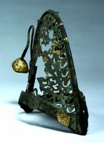
Japan, Kofun Period, 5th-6th century, Crown, gilt
bronze, excavated
from Funayama Tumulus, Kikusui-machi, Kumamoto, lower length
14.6 cm, height 16.5 cm, Tokyo
National Museum. Japanese authorities consider this to be a "National
Treasure." See crown.

Japan, Kofun Period, 6th century, Warrior in keiko type armor, terra
cotta haniwa tomb figure,
excavated at Iizuka-cho,
Ota-shi, Gunma, height 130.5
cm, Tokyo National Museum. Japanese authorities consider this
to be a "National Treasure."
Japan, Kofun Period, 6th century, Male Haniwa Figurine, height 75.0 cm, excavated at Wakiya, Gunma Prefecture. Japanese authorities consider this to be an "Important Art Object."

Japan, "Sue Potter," Kofun Period,
7th century, Tall-necked vase, excavated
from Kaniana Tumulus, Toba-shi, Mie, glazed
pottery, height
55.7, mouth diameter 24.0
cm, Tokyo National Museum. Japanese authorities consider this
to be an "Important Cultural Property." See vase.
![]()

![]()
kohl - A cosmetic preparation, such as powdered antimony sulfide, used especially in Egypt and other Middle Eastern countries as eye makeup. To the right is the "Eye of Horus" as seen on a fragment from an Egyptian coffin, designed to resemble the way kohl was used to darken the rims of the eyelids.
Kolinsky - Fur of the Siberian mink, hairs from which are used for the finest "sable" brushes.
Also see brush.
kore - A Greek statue of a clothed maiden. Greek, literally, for "girl".
(pr. KOH-ray)
Example:

Greece, Chios, c. 510 BCE,
Kore,
polychromed marble,
height 21 1/2 inches, Acropolis
Museum, Athens. This kore also wears a chiton.
Many detales are intricately carved.
The right arm originally reached out, and may have held an offering.
Although marble statues were often painted in ancient Greece,
very few examples of polychromey
are as intact as this one. Another point of view on this kore.
Korean art - [ Expect an in-depth article to appear here soon. ]

Korea, ancient region of Gaya, Three Kingdoms
period (57 BCE
- 668 CE),
Duck-shaped vessel, c. 200-300 CE,
earthenware,
Asian art Museum, San Francisco, CA.

Korea, Paeche or Kaya, 5th century CE
or earlier, Bowl with Attached Pedestal, unglazed
gray stoneware
with deposits of accidental ash glaze,
Worcester Art Museum, MA.

Korea, Openwork
Incense Burner, first half of the 12th century, celadon
glazed porcelain, height
15.3cm, National Museum of Korea. While fulfilling its function,
the design of
this incense burner juxtaposes
plant and animal motifs
with geometric openwork.
![]()

Korea, Koryo Dynasty, three vessels, 13th century, celadon
glazed porcelain.

Jiyeon and others (Korean), Joseon dynasty
(1392-1910), Guardian King of the West, 1796-1820,
hanging scroll, ink and mineral colors on linen
cloth, Asian art Museum, San Francisco, CA.
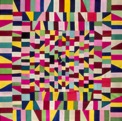
Korea, The Republic of Korea (1948-present),
Wrapping cloth, 1950-1960, silk patchwork,
Asian art Museum, San Francisco, CA. See textile.
Related resources:
kouros - A Greek statue of a male youth who may have been a god or an athlete. Greek, literally, for "young man".
(pr. KOO-raus)
Examples:

Greece, Attic, Kouros, c. 590-580 BCE,
Archaic, Naxian marble, height
without plinth 76 inches
(193.04 cm), Metropolitan Museum of Art, NY.

Greece, Calf Bearer (Moscophorous), c. 560 BCE,
marble, height
5 feet 5 inches, Acropolis Museum, Athens. This is not a kouros,
but an older man, as indicated by a beard. He is clothed and
bringing a calf to the temple, or altar, to make a sacrifice.

Greece, Kouros, c. 530 BCE
or modern forgery, Dolomitic
marble from Thasos, height
200 cm (80 inches), J. Paul Getty Museum, Los Angeles, CA.

Isamu Noguchi (American, 1904-1988), Kouros, 1944-45, marble,
height 9 feet 9 inches (297.2
cm); base: 34 1/8 x 42 inches (86.7 x 106.7 cm), Metropolitan
Museum of Art, NY. This figurative
and biomorphic modern
sculpture
is an abstraction of the human
figure of fragmented, bonelike components.
Kunstkabinett and Kunstkammer - Most literally, the German word Kunstkabinett means a "cabinet of curiosities," and a Kunstkammer is a "chamber of curiosities," exhibition spaces in which odd and wondrous rarities were brought together for private contemplation and pleasure. The words are German, but they are also used by speakers and writers of English because so many of the earliest (16th century) and best examples were created in Germany. Although the objects on display in these spaces were art objects, if some or all of the objects were marvels of nature, then they were instead called Wunderkabinetts and Wunderkammern. These precursors of the museum were developments of the Renaissance. The museum, on the other hand, was a creation of the Enlightenment.
A rule in writing German is that the first letter of every noun must be capitalized (common as well as proper nouns), so the first K's in these words are usually capitalized in English texts.
The plural of "Kunstkammer" is "Kunstkammern."
Kunstkabinetts and Kunstkammern very rarely remain today as they were in previous centuries. They are simultaneously pieces of furniture and the collections of objects within them, and naturally the selections of things in most were altered at the decision of their owners. The Getty Museum is justly proud of its empty cabinet (and title it Display Cabinet) because this exemplar remains so evocative of the high level of wonder its viewers must have taken in its presentation.
Example:
German (Augsburg), 1620-30, Display Cabinet, including three carvings by Albert Jansz. Vinckenbrinck (Dutch, about 1604-1664/65), ebony, chestnut, walnut, pearwood, boxwood, ivory, marble, semiprecious stones, enamel, palm wood, and tortoiseshell, 28 3/4 x 22 7/8 x 23 1/4 inches, J. Paul Getty Museum, Malibu, CA. This is one of 22 devices in the Devices of Wonder exhibit catalogued online by the Getty Museum — best seen with Flash and RealAudio plugins.
Related links:
Also see base, bin, easel, frame, gallery, portfolio, shadow box, and vitrine.
kunststückemachen - To juggle; and, more literally, to make a work of art.
Dutch sculptor Adriaen de Vries may have had this German word in his thoughts when he made:
![]()
Adriaen de Vries (Dutch, c. 1545-1626), Juggling Man, c. 1610 - 1615, bronze,
30 1/4 x 20 3/8 x 8 5/8 inches (77 x 51.8 x 21.9 cm), J. Paul
Getty Museum, Malibu, CA. See Mannerism
and movement.
Kush - See Meroitic art.
kyathos - A cup or dipper with a single high vertical handle. Among the other types of Greek vases are the amphora, hydria, krater, kylix, lekythos, oinochoe, pelike, phiale, pinax, pithos, pyxis, and rhyton.
kylix - In Greek and Roman antiquity, a shallow drinking cup with two horizontal handles, often set on a stem terminating in a foot. The plural form is kylikes. The earlier kylikes have a deep bowl and a low conical foot. Sometimes spelled cylix. Another type of two-handled drinking cup is a kantharos. (pr. ki:'licks) Among the other types of Greek vases are the alabastron, amphora, hydria, krater, kyathos, lekythos, oinochoe, pelike, phiale, pinax, pithos, pyxis, and rhyton.
Examples:
Greece, Kylix With Symposion Scene, attributed to the Painter of the Paris Gigantomachy, late Archaic, c. 480 BCE, terra cotta, Michael C. Carlos Museum, Emery U, Atlanta, GA.

Greece, Attic, attributed to the Villa Giulia
Painter, Kylix, c. 470 BCE,
Classical, red-figure and
white-ground, terra cotta, height 2 7/16 inches (6.2 cm),
Metropolitan Museum of Art, NY. On the interior, a goddess stands
beside an altar, about to
pour an offering from a phiale; on the exterior, obverse
and reverse, Eos pursues Tithonos. See attribution.
Also see glass, vase,
and vessel.
https://inform.quest/_art